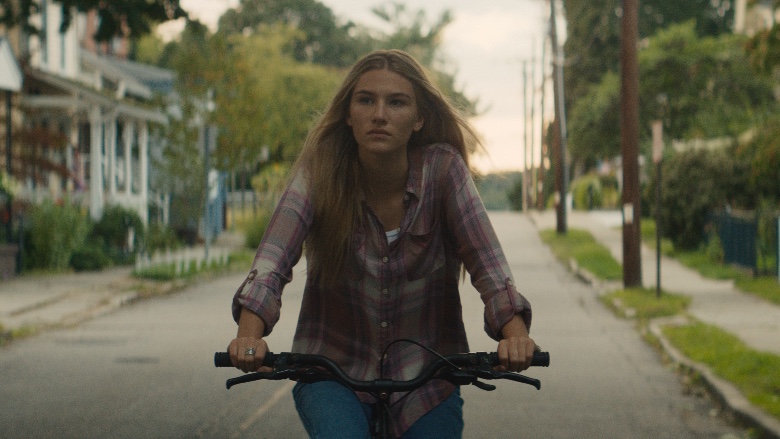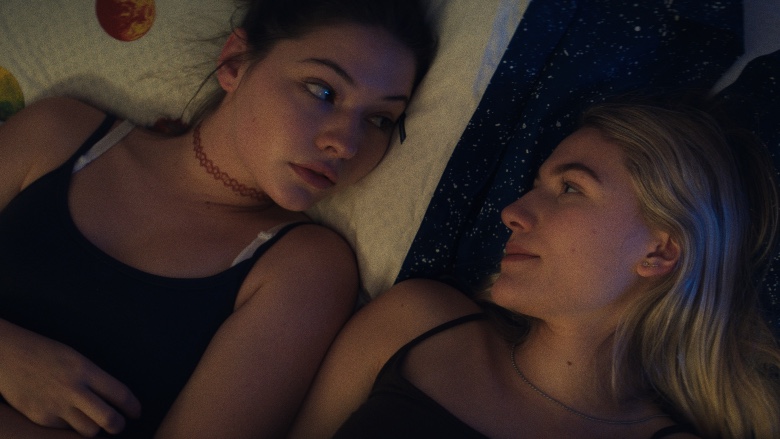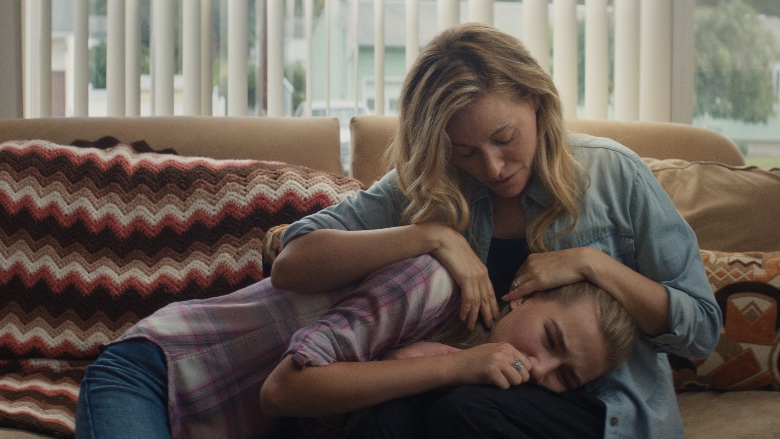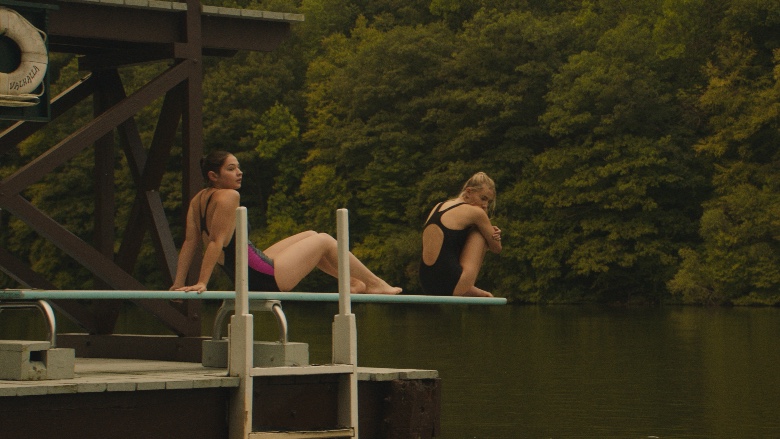
Writer/director Rebecca Eskreis‘ feature debut, What Breaks the Ice, is being brought to the American Film Market (AFM) this month by Goldcrest Films and Saboteur Media. The coming-of-age thriller recently had its world premiere at the Woodstock Film Festival where it appeared on a drive-in double bill with Francis Lee’s Ammonite, which comes out next week.
Eskreis’ debut stars Sofia Hublitz (Ozark), Madelyn Cline (Outer Banks), Joel Allen (The Purge) Shakira Barrera (Glow), Erik Jensen (For Life), Catherine Curtin (Orange Is the New Black), Aimee Mullins (Stranger Things) and Lukas Gage (Euphoria), as it explores the themes of teenage friendship and sexual assault in an idyllic resort town.
Set in 1998 and using the Monica Lewinsky scandal as a backdrop, What Breaks the Ice follows Sammy (Hublitz) and Emily (Cline), girls of despite divergent backgrounds who form a deep friendship over a summer in a small upstate New York resort town. Poised between the innocence of childhood and an adult world of simmering temptations, they share an untroubled bound until events take a sudden and drastic turn. Both a heart-stopping suspense story and a deep meditation on friendship and love, the film recalls a now lost teenage experience, absent technology, where connection was intense, pure and evanescent.
Eskreis developed the film under the mentorship of Oscar-nominated filmmaker Richard Linklater (Boyhood) and James Ponsoldt (The Specatacular Now) through the Austin Film Society‘s Artist Intensive program.
Below the Line recently spoke with Eskreis about her project, joined by Producer Michael Cuomo, Production Designer Megan Elizabeth Bell, and Cinematographer Greta Zozula.

Below the Line: What can you tell us about the genesis of What Breaks the Ice?
Rebecca Eskreis: I had been talking with Megan Bell and Dustin Dlouhy about doing a project together and sent them an early version of the script. Sometime later, while I was living in Austin, I had the opportunity to take part in a lab with Richard Linklater. Through that, I did another strong pass on the script and won a grant from the Austin Film Society. I also met Michael Cuomo, who produced the South by Southwest film The Light of the Moon. He brought on Michael Grey and another producer friend, Courtney Jones, became the last member of the production team. We decided to move forward with the money we had and started casting and building a crew. We approached Autumn Eakin, the cinematographer on The Light of the Moon, but she had a scheduling conflict. Instead, she suggested Greta. I had seen Greta’s work and knew how great she was. Choosing to work with her was one of the most rewarding decisions we made.
Megan Elizabeth Bell: As with most independent films, it’s “hurry up and wait” until it’s “go.” Then everything happens quickly. As we transitioned to production, there were a lot of moving parts. One of my favorite moments involved picture cars. The film is set in 1998, so we needed cars from that era. The art director and I arranged to meet a woman at a Dollar General parking lot, but we drove to the wrong one. On the way, we spotted a green Jaguar in another car lot. It was perfect for something we needed in a few days. I wrote down the number and contacted them, and they ended up helping us pull together picture cars for the whole film. It was kismet, like so many things associated with this project. It happened because we went to the wrong place.

BTL: Why is the film set in 1998?
Eskreis: I wanted to make a movie about 15-year-old girls, and I was 15 in 1998. But it’s more complex than that. People of my generation were the last to have an untethered childhood. You could walk out the door, not know what time it was, get lost, and no one could reach you. That doesn’t exist anymore. That freedom is an important theme of the story. Secondarily, the film deals with sexual relationships and sexual assault, with love and consent. There are grey areas there. And yet the media treated the Monica Lewinsky affair, which happened in 1998, as if it were black and white. I thought it was interesting to reflect on that issue as an adult. What messages are we internalizing about sexuality as growing women?
Michael Cuomo: This was my first time working on a period piece as a producer and there were a lot of challenges. One, as Meghan noted, was sourcing period cars. But, to follow up on what Rebecca said, I appreciated the subtlety in how the audience is introduced to the fact that the film is set in 1998. We hear snatches of conversations about the Lewinsky Affair. When the project was first presented to me, I was told that it involved sexual assault, but it’s actually about much more than that. It’s about the nature of female friendship and what happens to that friendship in a moment of crisis.
BTL: The film takes place in an upstate New York resort town and much of the story unfolds at the languid pace of a summer holiday. How did you achieve that effect?
Eskreis: Greta and I talked a lot about pacing. We made deliberate choices about what was going to be shot on sticks, what was gong to be handheld, what required a Steadicam. Most of that was emotionally motivated. The mood is the opposite of frenzied, the opposite of hurried. I wanted to sit with these girls, to get to know them in this beautifully gloomy, moody summer atmosphere.
Zozula: The weather worked out for us. We didn’t want a harsh, sunny kind of summer. We wanted something more romantic. As it turned out, we had cloudy weather for most of production. That gave the story a stuck-in-time, nostalgic feeling that worked really well.
BTL: The mood of the story shifts when we get to the rave. How did you approach that sequence?
Eskreis: From a narrative perspective, it starts when the three main characters arrive at the rave with their friends. They take ecstasy and suddenly everything becomes trippy and colorful. The scene looks and feels different from what has come before. It’s a turning point in the film. So, we have an almost romantic montage of the girls dancing and having fun until Travis takes a dark turn and the tone changes again. It’s reflected in the light and the music. We get the sense that he may be more dangerous than we thought. We shot that in a specific way. As Emily leaves, Travis appears through the darkness. That pattern is repeated several times in the film. From there, we go to Sammy. We follow her as she walks through the party in an elaborate, handheld sequence. She eventually discovers Travis and Emily in a truck. The situation escalates from there. We shot that sequence over four days, one night for the rave, one for the scene by the side of the road, one for the car driving with a process trailer, and one for POV shots of the truck driving fast.
Zozula: Each was shot at a different location. Our editor, Kathryn Schubert, did an amazing job of making it appear seamless.

BTL: Shooting that sequence must have been logistically challenging.
Cuomo: Scouting was one of the most eventful parts. The rave was initially meant to be shot at the lake. We had a conversation about the lake, the color of the water, the depth, mud, that type of thing, but Greta was quiet and I remember thinking that she didn’t like that location. We needed to keep looking. We then discussed a barn in Yorktown, but the problem was, the property owners said no.
Bell: They had a very packed schedule with their own events.
Cuomo: We reached out to people in Cold Spring who carry a lot of weight locally. They made a phone call and voila. We were lucky. Our prep time was short and that made everything more complex, but that is true for most independent films. We did our best and made it a team effort. If something needed to be done, regardless of your production position, you figured it out. It might seem odd that I, as a producer, got the job of driving the truck into the gully, but I didn’t look at it that way. It needed to get done.
BTL: What was it like to shoot the rave sequence?
Zozula: We shot the actors arrival, the drug scene, the rave itself and the accident all in one night. We pre-lit the interior early in the day and shot with two cameras, one set up on a gimbal. We started with a car rig and then played leapfrog the entire night. The camera department and electrical department were amazing. They stayed on top of everything. I trusted my gaffer to light without my having to check in. We talked about the strobes, their colors and how the pulses should feel, but I relied on him to get it done. Simultaneously, his team was lighting the night exterior. It was an incredible effort. Everyone had to be on the same page and execute perfectly. We did the drug take, then we hopped into the rave. As soon as we had that done, we went outside. The AD rotated the crew. We ended with the dream sequence, which was shot with the camera on the gimbal. By then we were running out of night, but the dream effect wasn’t meant to match with everything else. The early dawn light gave it an eerie look, so it worked out perfectly in the end.
BTL: Aside from the logistics, it must have been a very difficult scene to pull off because it involves a sexual assault.
Eskreis: No matter how much you plan, you make a lot of decisions in the moment. We chose to shoot the rape in a rape in a specific way, and part of it was due to circumstance. Yet, when I look back on it, it served the movie very well. We did test screenings early in the editorial process and found that parents were impressed with the way we handled that scene. They told us that they would feel comfortable watching it with their teenage children. So, I’m very happy with the decisions we made. It worked out very well.
What Breaks the Ice will play at AFM, which runs from November 9 to 13. It’s repped by Gretchen McGowan, Head of Production at Goldcrest Films, and David Kennedy from Saboteur Media.





